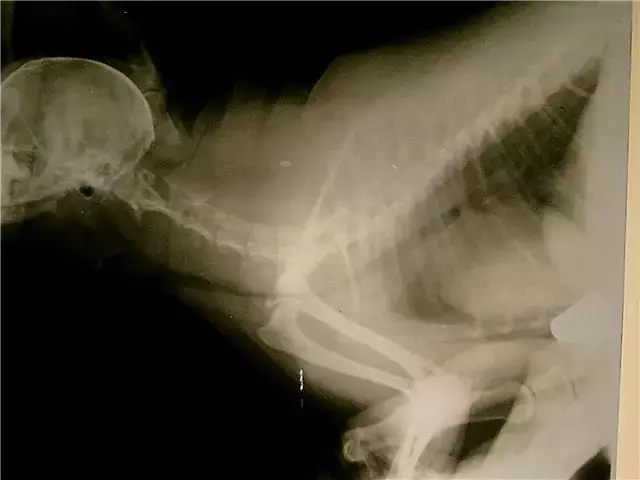- Author Rachel Wainwright [email protected].
- Public 2023-12-15 07:39.
- Last modified 2025-11-02 20:14.
Angioflux
Instructions for use:
- 1. Release form and composition
- 2. Indications for use
- 3. Contraindications
- 4. Method of application and dosage
- 5. Side effects
- 6. Special instructions
- 7. Drug interactions
- 8. Analogs
- 9. Terms and conditions of storage
- 10. Terms of dispensing from pharmacies

Angioflux is a direct-acting anticoagulant.
Release form and composition
- capsules: soft gelatinous, oval, brick-red; contents - a suspension of white or white-gray color, a pink or pinkish-cream shade is possible (10 or 25 pcs. in blisters, in a cardboard box, respectively 5 or 2 packages);
- solution for intravenous and intramuscular administration: transparent, from light yellow to yellow (2 ml in dark glass ampoules, 5 ampoules in a blister strip, in a cardboard box 2 packs).
The active substance is sulodexide:
- 1 capsule - 250 lipoprotein lipase units (LU);
- 1 ampoule with a solution - 600 LE.
Additional components of capsules:
- excipients: colloidal silicon dioxide, sodium lauryl sulfate, glyceryl caprilocaprate (Migliol 812);
- shell composition: gelatin, sodium propyl parahydroxybenzoate, sodium ethyl parahydroxybenzoate, glycerol, iron dye red oxide (E 172).
Auxiliary components of the solution: water for injection and sodium chloride.
Indications for use
- microangiopathy (retinopathy, nephropathy, neuropathy);
- angiopathy, accompanied by an increased risk of thrombus formation;
- macroangiopathy associated with diabetes mellitus.
Contraindications
- hemorrhagic diathesis and other diseases accompanied by hypocoagulation;
- I trimester of pregnancy;
- hypersensitivity to heparin or similar drugs;
- hypersensitivity to any component of the drug.
In the II and III trimesters of pregnancy, as well as during breastfeeding, Angioflux can be used only in cases of extreme necessity, after a careful assessment of the ratio of expected benefits and potential risks.
The composition of the solution for injection includes sodium chloride, and therefore in this dosage form the drug should be used with caution in patients adhering to a salt-free diet.
Method of administration and dosage
In the form of a solution, Angioflux is administered intramuscularly or intravenously (drip or bolus), 2 ml (contents of 1 ampoule) per day. For intravenous administration, the drug is injected, previously diluted in 150-200 ml of 0.9% sodium chloride solution.
Treatment is carried out for 15-20 days, after which the patient is transferred to the oral form of the drug.
In the form of capsules Angioflux should be taken orally between meals - 1 pc. 2 times a day for 30-40 days.
The full course of treatment is recommended 2 times a year.
The dose of the drug and the duration of treatment can be adjusted by the doctor depending on the results of the clinical and diagnostic examination of the patient.
Side effects
- when taking Angioflux in the form of tablets: pain in the epigastric region, nausea, vomiting, allergic reactions (skin rash);
- when using the drug in the form of a solution: burning sensation, soreness, hematoma at the injection site, allergic reactions (skin rash).
special instructions
Angioflux does not affect the speed of psychophysical reactions and the ability to concentrate.
If the combined use of antiplatelet agents or anticoagulants is necessary, blood coagulation indicators should be periodically monitored.
Drug interactions
Angioflux enhances the anticoagulant effect of heparin, antiplatelet agents and indirect anticoagulants. If possible, it is recommended to avoid their simultaneous appointment.
Analogs
Analogs of Angioflux are: Gemapaksan, Heparin Sandoz, Fraxiparin, Cybor, Wessel Douay F.
Terms and conditions of storage
Keep out of the reach of children at a temperature not exceeding 30 ° C.
The shelf life is 3 years.
Terms of dispensing from pharmacies
Dispensed by prescription.
Information about the drug is generalized, provided for informational purposes only and does not replace the official instructions. Self-medication is hazardous to health!






